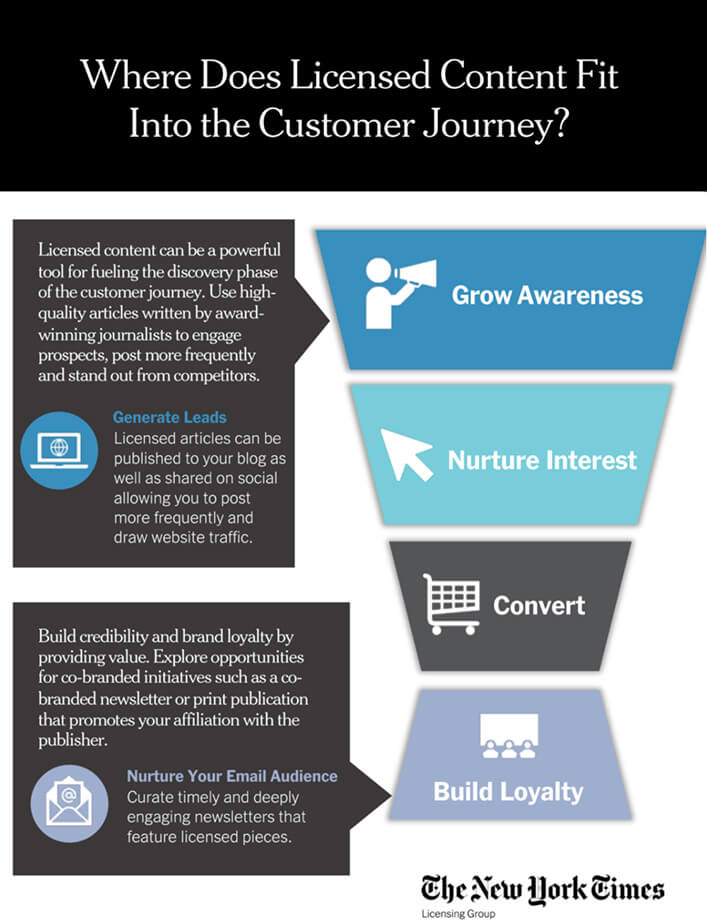Over the past several years, content marketing has solidified its standing as a central pillar in the marketing strategies of both business-to-consumer and business-to-business businesses. And while there’s no doubt that custom content pieces are vital to developing a brand’s voice, marketers are also using third-party content throughout the customer journey to demonstrate expertise and provide additional value.

What is a Customer Journey?
A customer journey, or buyer journey, is the process a prospect goes through from initial discovery of a brand, product or service to making a purchase. Buyer journeys are unique to each brand and vary from industry to industry. Whether depicted linearly, as a funnel or a circle, most customer journeys share common elements including four major stages that a prospect moves through: awareness, consideration, purchase and repurchase. From the marketer’s perspective, each stage serves a different objective with the goal of ultimately converting a lead. These objectives include growing awareness, nurturing interest, converting the sale and building loyalty.
Content and the Customer Journey
Content is one of the most effective tools for driving a buyer through the journey to a sale. Each stage of the journey requires distinct types of content that achieve different objectives. For example, the top funnel goal of growing awareness could include social posts on key social channels to draw new leads and familiarize customers with your brand. In terms of middle-of-the-funnel content, case studies can be leveraged to differentiate your brand from competitors and drive a buyer to ultimately make a purchase. Being aware of the stages your buyers go through and developing content that speaks to the buyer’s intent can help your content resonate and drive conversions. Keeping the buyer journey in mind will also inform which distribution channels make the most sense for reaching your prospects at every stage of the journey.
The Role of Content Licensing
Licensed content can be a critical support to marketers in several key stages of the buyer journeys including growing awareness, nurturing interest and building loyalty. Licensed articles from reputable publishers can be used to grow awareness through social channels. They can be published directly to your website and have the look and feel of your brand. These articles are typically written by talented storytellers and award-winning journalists, and feature attention-grabbing headlines that can help draw new prospects to your website when shared on social media. High-quality licensed articles can also nurture interest and drive loyalty when leveraged in email newsletters. As buyers embark on the customer journey, they will encounter various stages in the traditional content marketing funnel. These include:
Awareness:
In this stage, prospects are learning about the brand. Generally, content pieces explaining high-level concepts are a good fit for these users. Additionally, you can leverage high-quality journalism from publishers via content licensing to post frequently and establish credibility.
Nurture:
The nurture phase, also known as the middle of the funnel, is the stage where leads further learn about your company and its offerings. As your audience interacts with your brand more, this is the opportunity to further educate them on issues your company tackles. Content that addresses their pain points or content that feature thought leaders is a good match for this audience. Licensed content can strengthen credibility for your brand by leveraging expertise from outside sources.
Convert:
In this stage, prospects become clients. Customer testimonials, case studies and concise data sheets are good tools to use here, to show prospects what current clients think of your solutions.
Loyalty:
It costs about five times more to gain new customers than to keep a current customer. This is why it is so important not to forget your existing clientele. They are looking for industry expertise that your team can provide. Consider supplementing your current content strategy with articles from thought leaders and outside experts. Additionally, your team can create a co-branded newsletter or print publication that leverages a highly regarded publisher. This can further add credibility to your brand.
Using Content Licensing to Fuel Meaningful Connections
At The New York Times Licensing Group, we focus on providing content solutions that meet your customers at each stage of their journey. From fueling discoverability to boosting your output volume for newsletters, our licensed content can help you generate engagement while creating genuine, emotional connections between you and your audience.
